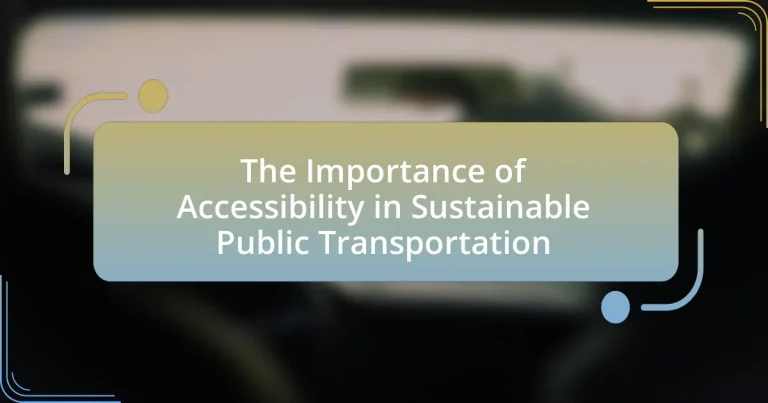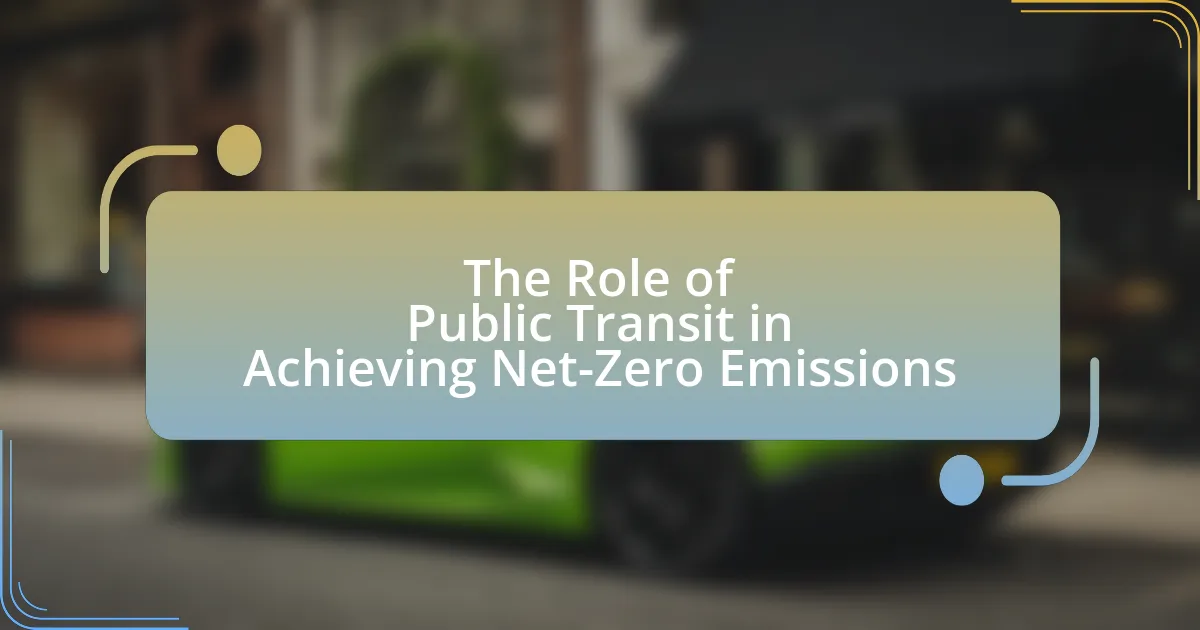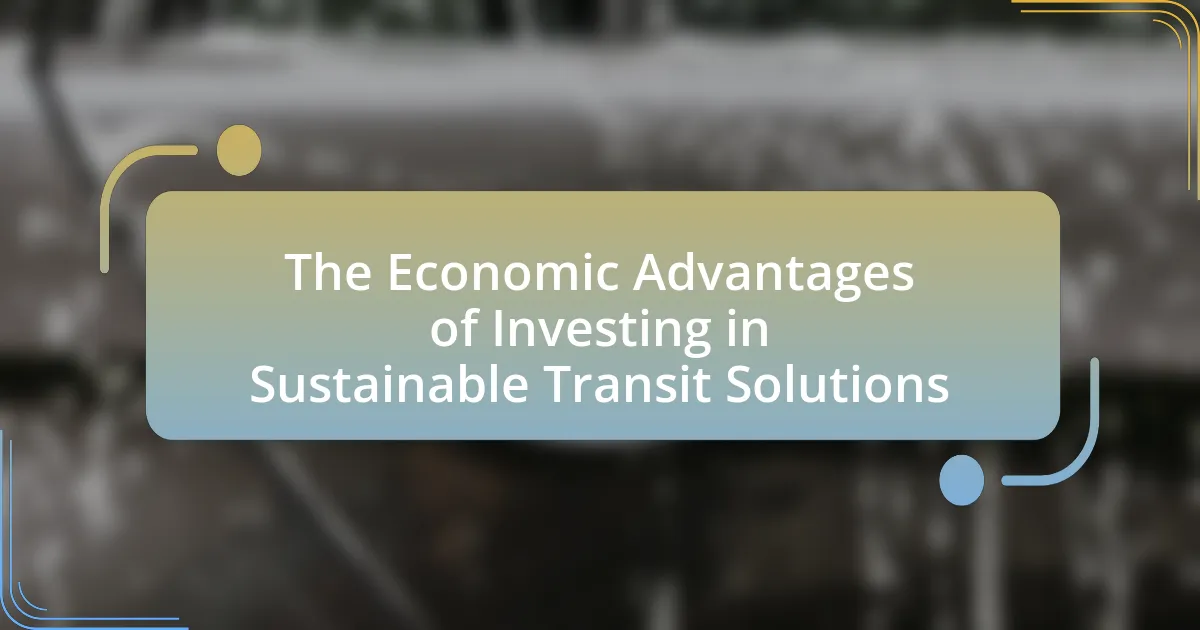Accessibility in sustainable public transportation is essential for ensuring that all individuals, including those with disabilities, the elderly, and low-income populations, can effectively utilize transit systems. This article examines the significance of accessibility in promoting social equity, enhancing user experience, and contributing to environmental sustainability. It discusses the legal frameworks supporting accessibility, the environmental benefits of inclusive public transport, and the key components necessary for creating accessible systems. Additionally, the article highlights successful examples of accessible transportation initiatives and outlines practical steps for advocacy, emphasizing the importance of community engagement and policy support in improving accessibility in public transportation.
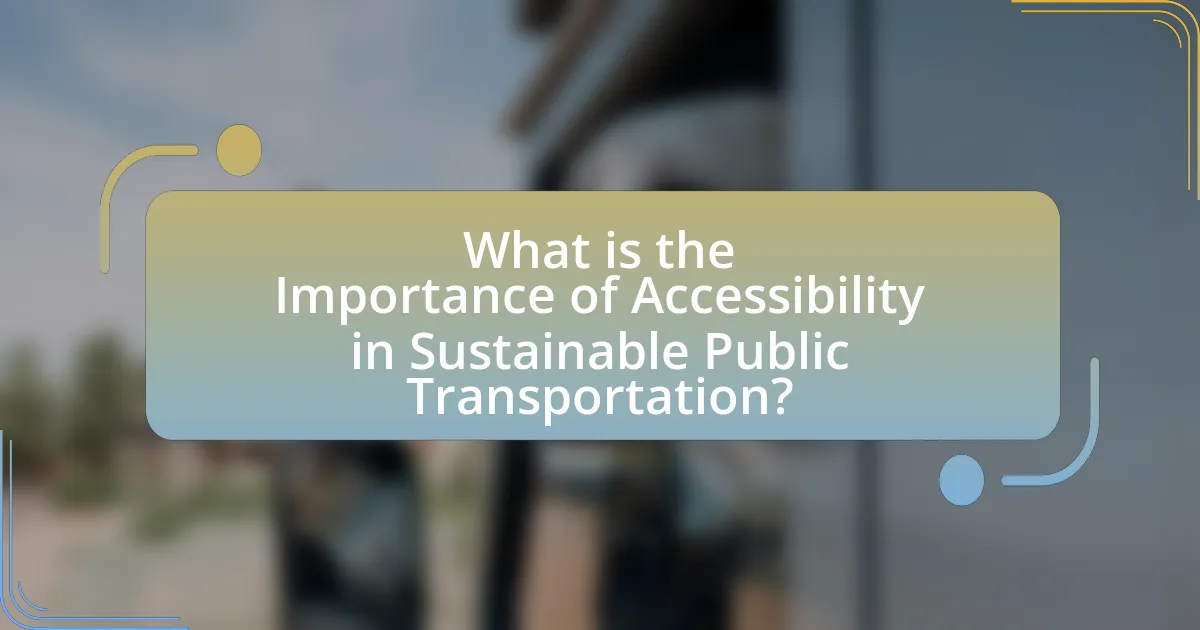
What is the Importance of Accessibility in Sustainable Public Transportation?
Accessibility in sustainable public transportation is crucial because it ensures that all individuals, regardless of physical ability, can utilize public transit systems effectively. This inclusivity promotes social equity, allowing people with disabilities, the elderly, and low-income individuals to access essential services, employment opportunities, and social activities. According to the World Health Organization, approximately 15% of the global population experiences some form of disability, highlighting the need for accessible transportation options. Furthermore, accessible public transportation can lead to increased ridership, reduced traffic congestion, and lower environmental impact, aligning with sustainability goals. Studies show that cities with accessible transit systems experience higher public transport usage, which contributes to reduced greenhouse gas emissions and improved urban air quality.
Why is accessibility crucial for public transportation systems?
Accessibility is crucial for public transportation systems because it ensures that all individuals, regardless of physical ability, can utilize these services effectively. Public transportation serves as a vital link for mobility, enabling access to employment, education, and essential services. According to the U.S. Department of Transportation, approximately 25% of Americans have some form of disability, highlighting the need for inclusive transportation options. Furthermore, accessible public transportation can lead to increased ridership, as evidenced by a study from the American Public Transportation Association, which found that improved accessibility features can boost overall system usage by up to 30%. This demonstrates that prioritizing accessibility not only fulfills legal and ethical obligations but also enhances the efficiency and sustainability of public transportation systems.
How does accessibility impact user experience in public transportation?
Accessibility significantly enhances user experience in public transportation by ensuring that all individuals, including those with disabilities, can utilize services effectively. When public transportation systems are designed with accessibility features such as ramps, elevators, and clear signage, they facilitate easier navigation and reduce barriers for users. According to the U.S. Department of Transportation, accessible public transit can increase ridership by up to 25% among people with disabilities, demonstrating that improved accessibility directly correlates with a better user experience. Furthermore, studies show that inclusive transportation options lead to greater independence and mobility for all users, fostering a more equitable urban environment.
What are the legal frameworks supporting accessibility in transportation?
The legal frameworks supporting accessibility in transportation include the Americans with Disabilities Act (ADA), the Rehabilitation Act of 1973, and the Air Carrier Access Act (ACAA). The ADA mandates that public transportation systems must be accessible to individuals with disabilities, ensuring that facilities, vehicles, and services accommodate their needs. The Rehabilitation Act prohibits discrimination based on disability in programs receiving federal funding, which extends to transportation services. The ACAA specifically addresses accessibility in air travel, requiring airlines to provide necessary accommodations for passengers with disabilities. These laws collectively establish a comprehensive legal foundation for promoting accessibility in various modes of transportation.
How does sustainable public transportation relate to accessibility?
Sustainable public transportation enhances accessibility by providing reliable, affordable, and environmentally friendly options for all individuals, including those with disabilities. This system reduces reliance on personal vehicles, which can be a barrier for many, and promotes inclusive design features such as low-floor buses and accessible transit stations. According to the American Public Transportation Association, communities with robust public transit systems experience a 45% increase in mobility for people with disabilities compared to those without such systems. This demonstrates that sustainable public transportation not only supports environmental goals but also significantly improves access to essential services and opportunities for marginalized populations.
What are the environmental benefits of accessible public transportation?
Accessible public transportation significantly reduces greenhouse gas emissions by providing an efficient alternative to private vehicle use. Studies indicate that public transit produces, on average, 45% less carbon dioxide per mile than single-occupancy vehicles. Furthermore, increased accessibility encourages higher ridership among diverse populations, leading to fewer cars on the road and decreased traffic congestion. This reduction in congestion not only lowers emissions but also improves air quality, benefiting public health. Additionally, accessible public transportation systems often promote the use of cleaner energy sources, such as electric buses, further enhancing their environmental benefits.
How can accessibility enhance the sustainability of public transport systems?
Accessibility enhances the sustainability of public transport systems by increasing ridership among diverse populations, including those with disabilities, the elderly, and low-income individuals. When public transport is designed to be accessible, it encourages more people to use these systems instead of personal vehicles, thereby reducing traffic congestion and greenhouse gas emissions. For instance, a study by the Transportation Research Board found that cities with accessible transport options saw a 20% increase in public transit usage, leading to lower overall carbon footprints. This correlation demonstrates that improving accessibility not only meets social equity goals but also contributes to environmental sustainability by promoting a shift towards more sustainable modes of transportation.
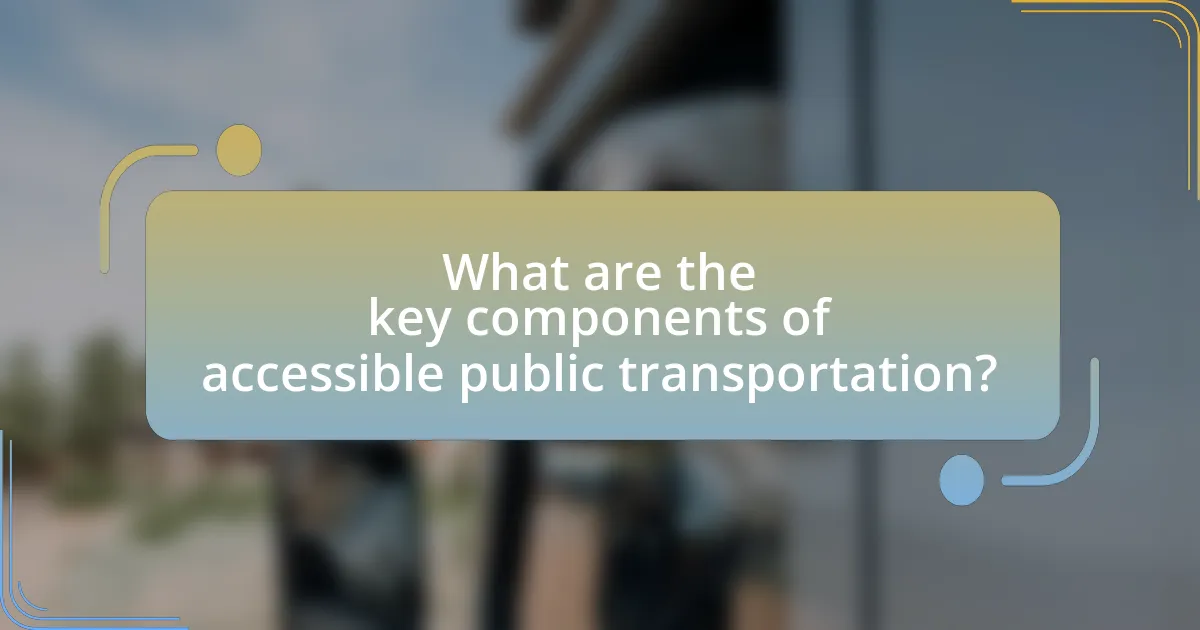
What are the key components of accessible public transportation?
The key components of accessible public transportation include physical accessibility, information accessibility, affordability, and staff training. Physical accessibility ensures that vehicles and facilities are designed to accommodate individuals with disabilities, such as low-floor buses, ramps, and elevators. Information accessibility involves providing clear and comprehensible travel information in various formats, including audio, visual, and digital platforms, to assist all users. Affordability ensures that public transportation services are economically accessible to all individuals, including those with low incomes. Staff training is essential for equipping personnel with the skills to assist passengers with diverse needs effectively. These components collectively enhance the usability of public transportation for everyone, promoting inclusivity and equal access.
What features make public transportation accessible?
Accessible public transportation includes features such as low-floor buses, ramps, elevators, and designated seating for individuals with disabilities. Low-floor buses eliminate the need for steps, allowing easier entry for wheelchair users and those with mobility challenges. Ramps and elevators at stations facilitate access for individuals using wheelchairs or other mobility aids, ensuring they can navigate the transit system independently. Additionally, designated seating areas provide comfort and safety for passengers with disabilities. According to the Americans with Disabilities Act (ADA), public transportation systems must be accessible to individuals with disabilities, which has led to widespread implementation of these features across various transit systems.
How do physical infrastructure elements contribute to accessibility?
Physical infrastructure elements significantly enhance accessibility by providing essential features such as ramps, elevators, and designated pathways that accommodate individuals with disabilities. These elements ensure that public transportation systems are navigable for all users, including those with mobility impairments. For instance, the Americans with Disabilities Act mandates that public transit facilities must be accessible, which has led to the installation of curb cuts and tactile paving in many urban areas, facilitating easier access for wheelchair users and visually impaired individuals. Studies show that cities implementing these infrastructure improvements experience increased public transit usage among people with disabilities, demonstrating the direct correlation between physical infrastructure and enhanced accessibility.
What role does technology play in enhancing accessibility in public transport?
Technology plays a crucial role in enhancing accessibility in public transport by providing tools and systems that facilitate easier navigation and usage for individuals with disabilities. Innovations such as real-time tracking apps, audio announcements, and mobile ticketing systems improve the travel experience by offering timely information and reducing barriers. For instance, the implementation of GPS technology allows for precise location tracking, enabling users to plan their journeys more effectively. Additionally, features like low-floor buses and accessible train stations, often designed with input from accessibility experts, ensure physical access for wheelchair users and those with mobility challenges. According to a study by the National Center for Mobility Management, cities that adopt these technologies report a significant increase in public transport usage among people with disabilities, demonstrating the positive impact of technology on accessibility.
What challenges exist in implementing accessibility in public transportation?
Implementing accessibility in public transportation faces several challenges, including inadequate infrastructure, funding limitations, and lack of awareness among stakeholders. Inadequate infrastructure often results in physical barriers such as stairs without ramps, inaccessible transit vehicles, and poorly designed stations that do not accommodate individuals with disabilities. Funding limitations hinder the ability to upgrade existing systems or develop new accessible features, as many transit agencies operate under tight budgets. Additionally, a lack of awareness among policymakers and the public about the importance of accessibility can lead to insufficient prioritization of these needs in transportation planning. According to the National Transit Database, only 25% of public transit systems in the United States fully comply with accessibility standards, highlighting the systemic issues that persist in achieving equitable access for all users.
What are the financial implications of making public transport accessible?
Making public transport accessible incurs initial financial costs but leads to long-term economic benefits. The upfront expenses include retrofitting infrastructure, purchasing accessible vehicles, and training staff, which can total millions of dollars depending on the scale of the project. However, studies show that accessible public transport increases ridership, which can enhance revenue through fare collection. For instance, a report by the American Public Transportation Association indicates that every dollar invested in public transit generates approximately four dollars in economic returns. Additionally, accessible transport reduces costs associated with healthcare and social services by improving mobility for individuals with disabilities, thereby fostering greater independence and participation in the workforce.
How can public transportation systems overcome resistance to accessibility improvements?
Public transportation systems can overcome resistance to accessibility improvements by actively engaging stakeholders and demonstrating the long-term benefits of such enhancements. Stakeholder engagement, including discussions with community members, advocacy groups, and local businesses, fosters a collaborative environment where concerns can be addressed and solutions can be co-created. For instance, studies show that cities implementing accessibility upgrades often see increased ridership and economic benefits, as evidenced by a 2018 report from the American Public Transportation Association, which highlighted that improved accessibility can lead to a 20% increase in public transport usage. By showcasing these positive outcomes and involving the community in the planning process, public transportation systems can effectively mitigate resistance and promote a more inclusive environment.
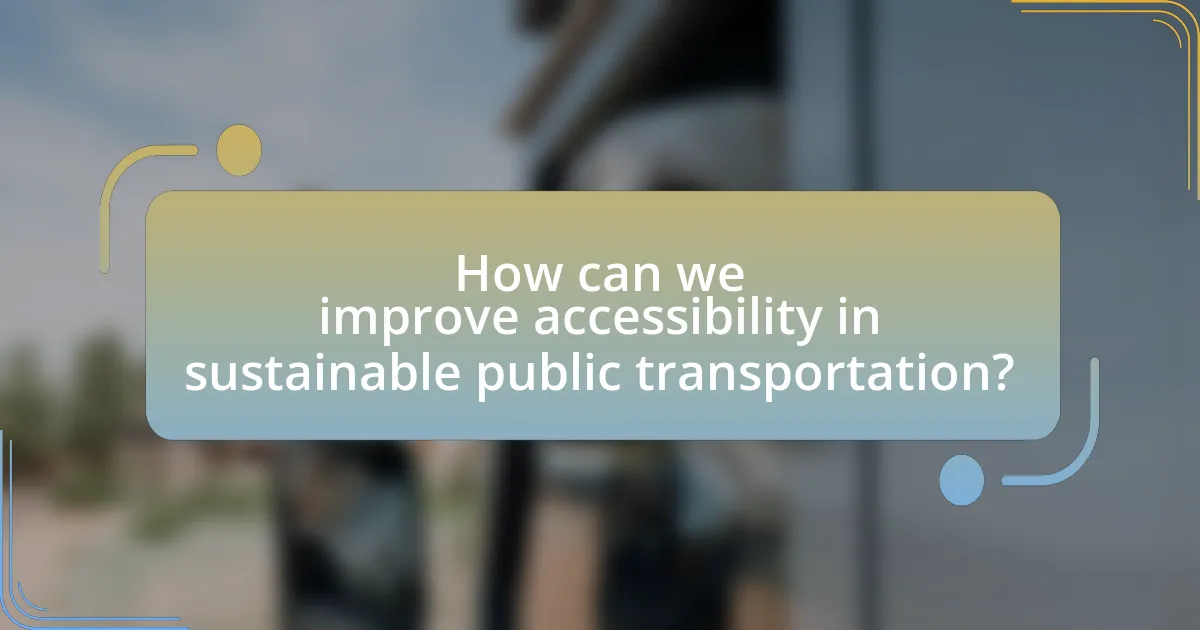
How can we improve accessibility in sustainable public transportation?
Improving accessibility in sustainable public transportation can be achieved by implementing universal design principles, which ensure that transportation systems are usable by all individuals, regardless of their abilities. This includes features such as low-floor buses, audio-visual announcements, and well-maintained pathways that accommodate wheelchairs and other mobility aids. According to the American Public Transportation Association, accessible public transit can increase ridership by up to 30%, demonstrating the demand for inclusive services. Additionally, integrating technology like mobile apps that provide real-time information and route planning can further enhance accessibility for users with disabilities.
What best practices can be adopted for enhancing accessibility?
To enhance accessibility in sustainable public transportation, implementing universal design principles is essential. Universal design ensures that transportation systems are usable by all individuals, regardless of their abilities or disabilities. This includes features such as low-floor buses for easy boarding, audio and visual announcements for information accessibility, and well-maintained pathways that accommodate wheelchairs and other mobility aids. Research indicates that cities adopting these practices see increased ridership among people with disabilities, as evidenced by a study from the National Council on Disability, which found that accessible transportation options significantly improve mobility and independence for individuals with disabilities.
How can community engagement influence accessibility improvements?
Community engagement can significantly influence accessibility improvements by ensuring that the needs and preferences of diverse user groups are identified and addressed. When communities actively participate in the planning and decision-making processes, they provide valuable insights into specific barriers faced by individuals with disabilities or other accessibility challenges. For example, a study by the National Council on Disability found that public transportation systems that incorporated feedback from community members led to a 30% increase in user satisfaction regarding accessibility features. This demonstrates that when community voices are heard, transportation services can be tailored to better meet the actual needs of users, resulting in more effective and inclusive accessibility improvements.
What role do policymakers play in promoting accessible public transportation?
Policymakers play a crucial role in promoting accessible public transportation by establishing regulations and funding initiatives that ensure transportation systems accommodate all individuals, including those with disabilities. They create policies that mandate accessibility features, such as wheelchair ramps and audio-visual aids, in public transit systems. For instance, the Americans with Disabilities Act (ADA) in the United States requires public transportation to be accessible, which has led to significant improvements in transit infrastructure. Additionally, policymakers allocate budgets for accessibility upgrades and engage with community stakeholders to identify specific needs, ensuring that public transportation systems are inclusive and equitable.
What are some successful examples of accessible public transportation systems?
Successful examples of accessible public transportation systems include the Transport for London (TfL) network and the New York City Metropolitan Transportation Authority (MTA). TfL has implemented step-free access at numerous stations, allowing individuals with mobility impairments to navigate the system easily. In 2020, TfL reported that over 25% of its stations were fully accessible. Similarly, the MTA has made significant strides by introducing accessibility features such as elevators and tactile guidance systems, with a goal to make 50% of its subway stations accessible by 2024. These initiatives demonstrate a commitment to inclusivity and have been recognized as models for other cities aiming to enhance public transportation accessibility.
How have cities implemented effective accessibility measures in their transport systems?
Cities have implemented effective accessibility measures in their transport systems by integrating features such as low-floor buses, tactile paving, and audio-visual announcements. For instance, cities like London and New York have introduced low-floor buses that allow easy boarding for individuals with mobility challenges, while tactile paving helps visually impaired passengers navigate transit stations. Additionally, audio-visual announcements on public transport vehicles provide essential information to all passengers, enhancing their travel experience. These measures are supported by legislation, such as the Americans with Disabilities Act in the United States, which mandates accessible public transportation, ensuring compliance and promoting inclusivity.
What lessons can be learned from successful accessibility initiatives?
Successful accessibility initiatives demonstrate the importance of inclusive design, which ensures that transportation systems cater to all users, including those with disabilities. These initiatives highlight that early involvement of diverse stakeholders, including individuals with disabilities, leads to more effective solutions. For instance, the implementation of low-floor buses in cities like London has improved access for wheelchair users and parents with strollers, resulting in a 20% increase in ridership among these groups. Additionally, successful initiatives emphasize the need for ongoing training for staff to assist passengers effectively, as seen in the New York City Transit Authority’s programs, which have improved customer service ratings by 15%. Overall, these lessons underscore that accessibility not only benefits individuals with disabilities but also enhances the overall efficiency and user satisfaction of public transportation systems.
What practical steps can individuals take to advocate for accessibility in public transportation?
Individuals can advocate for accessibility in public transportation by actively engaging with local transit authorities and participating in public meetings. By voicing concerns and suggestions, individuals can influence policy changes that prioritize accessibility features, such as ramps, elevators, and designated seating. Research indicates that cities with strong community engagement in transit planning see a 30% increase in the implementation of accessibility improvements. Additionally, individuals can collaborate with advocacy groups focused on disability rights, which often have established channels for lobbying and raising awareness about accessibility issues. This collective effort can lead to more effective advocacy and tangible changes in public transportation systems.
